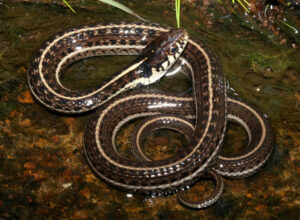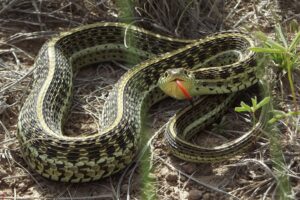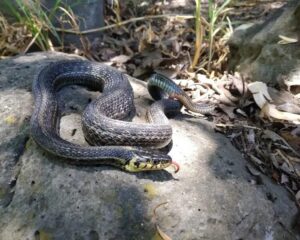The Mexican garter snake is an essentially harmless, semi-aquatic colubrid that is relatively stout-bodied and long. It is most active in the warmer months and mostly seen in the morning.
Scientific Classifications
- Suborder:Serpentes
- Family:Colubridae
- Genus:Thamnophis
- Species:T. eques
Conservation Status
Subspecies
This snake has ten recognized subspecies.
- Mexican garter snake (Thamnophis eques eques)
- Laguna Totolcingo garter snake (Thamnophis eques carmenensis)
- Thamnophis eques cuitzeoensis
- Thamnophis eques diluvialis
- Thamnophis eques insperatus
- Northern Mexican garter snake (Thamnophis eques megalops)
- Thamnophis eques obscurus
- Thamnophis eques patzcuaroensis
- Thamnophis eques scotti
- Thamnophis eques virgatenuis
Description
Size
Adults reach a length of 44 in (112 cm) on average. It can reach a maximum length of 3.3 ft (1m).
Color and Appearance
The ground color is brown, black, olive, rust or tan. There are three creamy yellow stripes, one down its back and the other two down each side. Dark blotches may be present on each side of the neck. Its head is noticeably larger than other garter snakes with black outlined scales on the lower face.
Are They Dangerous to Humans
On encountering a human, the secretive garter snake flees. However, if threatened or handled, it strikes repeatedly and bites. It also smears a foul-smelling musk and feces on the attacker. But it is non-venomous and can cause no harm to humans.
Mexican Garter Snakes at a Glance
Distribution
This garter snake lives in Mexico and the United States (New Mexico and Arizona).
Habitat
It is rarely found away from dense vegetation and permanent water bodies. It inhabits cienega-streams, cienegas, and cottonwood-willow riparian areas in low to mid elevations of 1720-6150 ft (530-1875 m).
The species has undergone a decline in its population due to habitat alteration and destruction. Introduction of exotic predators (bullfrogs) in its native habitat has also contributed to the fall in its numbers.
Lifespan
The garter snake lives for 10-12 years.
Predators
Bullfrogs prey on the colubrid that tries to defend itself by burrowing and hiding its head.
Diet
The primary diet of the Mexican garter snake consists of frogs and fish though it is known to take lizards and small rodents.
Reproduction
Ovoviviparous (gives birth to live young from eggs that hatch inside the body)
Between late May to early July a female gives birth to up to 25 live young in a litter.
Source
flickr.com, .inaturalist.org, animalia.bio








